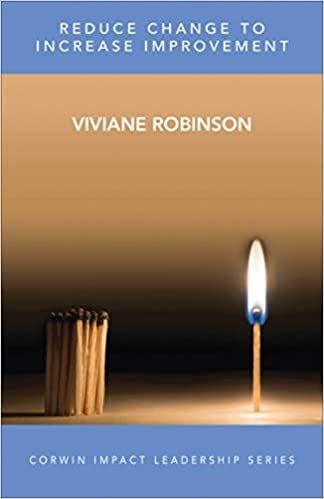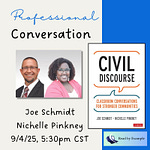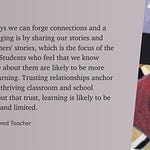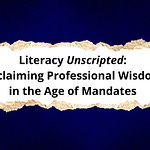Communicating feedback to teachers is one of the most challenging aspects of leadership. How do we influence instruction in a positive way while maintaining trust and respecting teachers as professionals?
Dr. Viviane Robinson, author of Reduce Change to Increase Improvement (Corwin, 2017), offers readers sound research and rich examples for supporting teaching and learning in all classrooms. In this episode, we discussed:
The difference between “change” and “improvement”,
Why feedback needs to be anchored first in student outcomes, and
How to engage in conversations with teachers that builds trust.
Educational leadership is difficult work. The ideas and strategies described here can help make this work a little easier and a lot more effective for instructional improvement.
Related Resources
Full Transcript
Matt Renwick (00:05)
I'd like to welcome Dr. Viviane Robinson. She is the distinguished professor emeritus at the University of Auckland-New Zealand. She's also the director of Viviane Robinson Consulting Limited, and the author of the book that we're talking about today, Reduce Change to Increase Improvement and is part of the Core Impact Leadership Series. Welcome Dr. Robinson.
Viviane Robinson (00:30):
Thank you, Matt. It's lovely to be speaking with you.
Matt Renwick (00:33):
And I picked up your book at a conference and I was really interested in your title. It's Reduce Change to Increase Improvement. It's an interesting frame, and I was just curious, change and improvement can be sometimes synonymous. Could you just explain the distinction and why it became the topic of your book?
Viviane Robinson (00:54):
Well, it became the topic of my book, Matt, because in my work with school leaders it seemed, in school improvement, I've seen too much change that has not led to improvement, and you'll be familiar with the cycles of reform that happened in our schools. One set of reforms after another that have patchy results at best. So, I think that that's very debilitating, for the effort, energy and motivation of teachers and leaders, but it's also not serving our students well, because the problems that these reforms were designed to solve persist. And the one I'm thinking of in particular is the equity problem. Change is simply the process of doing something different. That's all. Change means that we're doing something different. The thing we're doing different could be the same or worse or better than what happened before improve.
Viviane Robinson (01:55):
If we shoot for improvement rather than change, it means right from the outset, we have to say, "What's wrong with the status quo?" Okay. And many leaders bring in changes without saying why teachers need to be going through all the hassle of that. So we need to, if we're talking about improving, we need to be upfront right from the beginning about the fact that we want things to be better. Doesn't mean they're terrible now, but they have to be better. That's usually driven by student results, social outcomes, academic outcomes. And then if we're talking about improvement, we'd better have a jolly good idea about why, what we're proposing is going to be better because it takes a lot of time, money, and effort. So I want to encourage leaders to be more forthright in their intention, more honest and more ambitious. They're not interested in change, or they shouldn't be, they should be interested in improvement.
Matt Renwick (03:10):
That sounds great. And I think the way you frame it and I read it, but just hearing it again, just helps me remind myself of the distinction as they prepare for a new school year too. So thank you for explaining that. In your book you cited a previous meta-analysis that you were involved in, thinking about change, you noted that the one leadership practice, "leading teacher learning and development", had the largest impact on student outcomes. What about this practice is so powerful for student learning?
Viviane Robinson (03:42):
Well, I think there's a number of reasons. When I ask leaders why they think it and teachers why they think it's so powerful, they tend to say because of the symbolic importance that the leader can spend time being involved with the professional learning, then that sends a very powerful symbolic message to teachers about how it must be important. And that's true. But I actually think that there are other reasons as well. One of the most powerful ways a leader can gain influence with teachers is through helping them solve their problems of teaching and learning. The more leaders know, the more they themselves learn, the more able they are to help teachers solve their classroom problems. And that increases the sphere and intensity of influence that leaders have over teachers. So teachers come to them and seek help and they learn from the leader or with the leader - together - with the leader.
Viviane Robinson (04:57):
So that's a second reason. The third reason is that if we're going to succeed and solving the equity problems that bedevil all of us, then that's hard work. Lots of very smart and dedicated people have failed to solve those problems before us. And the reason why we are not very good at solving them is because we don't have sufficient specialist knowledge. If you want to improve maths problem solving or literacy, secondary level science literacy, for example, that's a very specialist area. And I think we underestimate how much we need to learn in order to solve those problems. Most of the difficulty is not about teacher will. It's about teacher capability, teacher and leader capability. So school culture, which has a culture of dedication to professional learning, not as a menu of opportunities - that's hopeless - but as professional learning to solve problems that are anchored in student outcomes, that is a powerful school culture. And it's a powerful way of leading.
Matt Renwick (06:31):
Yeah. When I speak with my teachers, when I visit classrooms, it would be hard for me to have a conversation with them without having that same set of knowledge and skill development that, you know, we're both trying to go through.
Viviane Robinson (06:45):
Yes, yes. And you said both trying to go through Matt and I think that's the point, especially at secondary level, even at primary. I'm not asking leaders to know everything; that would be ridiculous. We're not going back to heroic leadership, that I am asking them to lead a very focused, intense, collaborative learning process, where people stick at it until the student outcome problem is solved.
Matt Renwick (07:19):
That is part of it too, is committing to it long-term. And having that patience to follow through. I highlighted one quote from your book that kind of relates to engaging teachers. In those conversations, you said "Careful inquiry into teachers' theory of action gives leaders insight into teacher's concerns and enhances access to the levels of change." And could you just say more about that and what this inquiry might look like?
Viviane Robinson (07:46):
Yes. In the book I've got transcripts of the actual conversations to illustrate what you actually say. I think in order to have these conversations, the starting point for leaders, all the relations with teachers should be the experience or outcomes of students. That's your starting point. So for example these particular teachers, students are very good at maths fluency, but they're very limited in their math problem solving, right? So to know that, that's your starting point and this connects to your question about feedback as well. Then your next step is to investigate, inquire into what might the teachers of those students be doing and not doing. So that directs your inquiry, your observations with the collaboration, of course, into their practices. How are they teaching maths in a way that might connect with the low scores in maths problem-solving, okay?
Viviane Robinson (09:08):
So you then focus on that. You may need some specialist help and knowing what to look for when you go into that classroom. Then you discover how they're teaching. You summarize it. You get agreement with the teacher that yes, that's how they're teaching. Now, normally leaders stop at that point. But if they're doing a deep inquiry, they [leaders] say, "Can you talk to me about why you're using so many quizzes and worksheets? Talk to me about why you're not using rich text." Then you will discover a goldmine of beliefs, fears, anxieties, prior experience, horrible experiences that that teacher will talk to you about. And when you can connect the teacher's beliefs with what they do and don't do, and the outcomes for students, then you have knowledge of their theory of action. And boy, that's powerful because it's the causes of their practices.
Matt Renwick (10:18):
So critical too, to have that trust. I think for them to be able to admit, these are my concerns, these are my beliefs.
Viviane Robinson (10:26):
Well, when we teach this in our leadership development courses, we've got videos that show how to do this in seven minutes. And the transcripts in the book are no longer than that. So it's about the leader's skill and incorporate the latest ability to say, "Look, I really want to know why you're just using quizzes and worksheets, and this is not a blame game. Unless we can together talk about this and understand the barriers you've experienced," - notice my language - "the barriers you've experienced, then I can't suggest any way of helping you, because I need to know what's important to you." Now that sentence, that sentence creates trust.
Matt Renwick (11:19):
Yeah. It's a very empathetic response, and it takes their perspectives. And I very much appreciate that, but this is a tough skill too. I mean, it's something I've worked on. And I know in your book, you talk about the two approaches that leaders take: bypass versus engagement. And why do leaders like myself at times tend to default to the former approach, to bypass, even when we know at some level that engagement with teachers' thinking and actions are more effective.
Viviane Robinson (11:49):
Well, there's a number of reasons. One is that your bosses, your superintendents probably expect you to implement this reform, have this professional learning in your school, do this, fix this, fix that. Now I don't know Matt, what sort of school you run and what your situation is. But that happens to a lot of leaders, in other words, the "fix it mentality". And the fix it mentality means that you see the results and then you immediately move to, well, what are we going to do? That's different. What changes are we going to make? So they have pressure which leads leaders to bypass the theories of action of teachers. And it produces this churn of reform as teachers comply or not, and still have their fears and anxieties about doing it, and what's going to happen with their students and their classrooms unaddressed.
Viviane Robinson (12:59):
So that's one reason: the pressure to fix it. Another reason is the one you've spoken about, which is that, people are not very good at empathic inquiry, at actually discovering a theory of action. And they believe that it's going to take a lot of time, which it doesn't, as I said: all our videos about how to do this take no longer than seven minutes. And that's a lot less time then pushing and pushing and pushing and getting nowhere. So that belief that it's going to take too long, and then leaders fear that they're going to upset their teachers. If they do causal inquiry at all, they will inquire and they will get responses about students' background and the previous years' teachers and things like that. And they will be very reluctant to say, "Well, actually, I wonder whether there's something that you're unwittingly doing or not doing in the class that may be contributing to this. I'm not saying it is, but let's explore that because we need all hypotheses on the table." And again, notice my language: "hypotheses". All right? Now that takes one sentence to make that shift from talking about what's wrong with the students to raising the possibility about teaching in class.
Matt Renwick (14:39):
Much more objective and evidence driven, which can really help with having those conversations and keeping the, I guess, the ego out of it is as much as possible. And just be more evidence-based. We were previously exchanging in a conversation around how to effectively communicate feedback to teachers. And I appreciate you encouraging me to continue to expand on this concept, you've had some nice examples in here. Any other suggestions for getting started in this process, and to experience some kind of quick success with it, so they [leaders] want to keep doing it?
Viviane Robinson (15:21):
I think rather than again, making it very complicated reform around instructional walks, you might eventually get to that, but you keep it simple: feedback should be anchored in what's happening for students. Okay. That's what it should be. So what's your purpose in giving feedback? Your purpose is to help the teacher do a better job for particular students. That's its purpose. It's not surveillance, it's not compliance. It's not checking up. It's not because the state requires a principal to make so many visits a term or a semester to every teacher's classroom. It's because you're there, it's because you and the teacher are examining your impact on students. So if you've got students that have a poor relationship with a teacher, then your feedback to their teacher, you start negotiating a process of trying to figure out why that is.
Viviane Robinson (16:32):
And you direct your feedback towards investigating that. Now often that's not about observing in the class. That might be about talking with the student either together or separately or both. So the first step is that the teacher and you agree there is a student problem to be solved. And I don't mean a problem with the student. I mean, a problem in the interaction between the school and the student or the teacher and the student, or the way the subject is being taught and the student, that's the starting point, that's the purpose. And that builds common ground and trust. And then together you're investigating, what's the cause of that problem. And the feedback is about that based on your evidence. Again, it's not, "I'm coming in with a checklist or a protocol, and I'm going to go through the protocol and give you feedback because that's the protocol."
Matt Renwick (17:37):
It seems like a more responsive and grounded approach to the actual classroom. There's an actual problem of practice they're trying to solve. Well, this has great. I enjoyed your book. I appreciate that it was just a shade over a hundred pages. As a busy principal, that was wonderful. Where can we learn more about your resources that leaders could take advantage of?
Viviane Robinson (18:06):
There's a previous book. You talked about the meta-analysis that had shown that leading professional teacher learning is a very powerful form of leadership in terms of its impact on the students of the teachers who are participating in the professional learning. And that's all written up in my 2011 book, Student-Centered Leadership. All the professional development work that we're doing is commercial. And if you want to be part of that or to talk about that, you'd probably need to do that in partnership with your district.
Matt Renwick (18:49):
Well, thank you, Dr. Robinson.
Viviane Robinson (18:50):
You're welcome.











